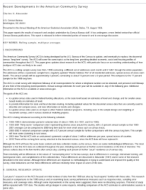Recent Developments in the American Community Survey
Recent Developments in the American Community Survey
Introduction
The American Community Survey (ACS) is being developed by the U.S. Bureau of the Census to update, and eventually to replace, the decennial census "long form" survey. The ACS will cover the same topics as the long form, providing detailed economic, social and housing profiles of communities throughout the U.S. This paper gives updates about research on the ACS, with particular focus on our evolving understanding of how multiyear ACS data are likely to be used.
The ACS is a rolling sample survey (see Kish, 1998) contacting a different set of addresses each month until it "rolls" through the entire population. The addresses will be a systematic sample from a regularly updated "Master Address File" of all residential addresses, spread across all areas each month. The annual sample will be approximately 3 percent, cumulating to about 15 percent over a 5-year period. This compares to the 17 percent sample for the 1990 long form.
The ACS is a mail survey with telephone followup of all nonrespondents for whom a telephone number can be obtained, and personal visit followup of one-third of the remaining nonrespondents. Annual average estimates for each year will be available in July of the following year. Additional information on the ACS is available at www.census.gov.
The goals of the ACS are:
- to update census data used in federal funding allocations, at the state level based on estimates of level and change, and for smaller areas based mainly on estimates of level;
- to provide information for state and local decision-making, including updated values for the decennial census data that are currently used to describe and compare areas, and new information on trends and changes;
- to update census data used as an input to other Federal statistical programs, including uses in the sample design and weighting of household surveys, and in various statistical modeling projects.
The ACS is being introduced according to the following schedule:
- 1996-1998 A demonstration period in selected sites (4 sites in 1996, 8 in 1997, and 9 in 1998).
- 1999-2001 Thirty-seven "comparison sites" representing diverse areas around the country, with a 5 percent annual sample so that 1999- 2001 averages can be compared to 2000 long form data for even small areas such as census tracts.
- 2000-2002 A national comparison sample with a 0.7 percent annual sample for further comparisons with the census long form. This sample will have some clustering in rural areas.
- 2003-later The full ACS with an unclustered systematic sample of about 3 million addresses per year, spread across all counties.
- 2010 There will be no long form survey attached to the decennial census, since the ACS data will have replaced it.
Although the ACS will have the same basic content and data collection modes as the census, there are some methodological differences. The most important is that the ACS data are collected throughout the year, including each person at his/her current residence at the time of interview. The census collects data in the few months after census day, counting each person at his/her "usual" residence as of census day.
There inevitably will be differences in the nature of "nonsampling error" in the two surveys, due to differences in coverage, interviewer training, unit nonresponse rates, and completeness of the collected data. These differences are discussed in Alexander (1997) and in some of the research described in the next section. Although these differences are important to methodologists in trying to understand and improve the quality of the survey, initial indications are that these differences will have relatively minor impact on users of the data.
Others in Series
Working Paper
Working Paper
Working Paper




